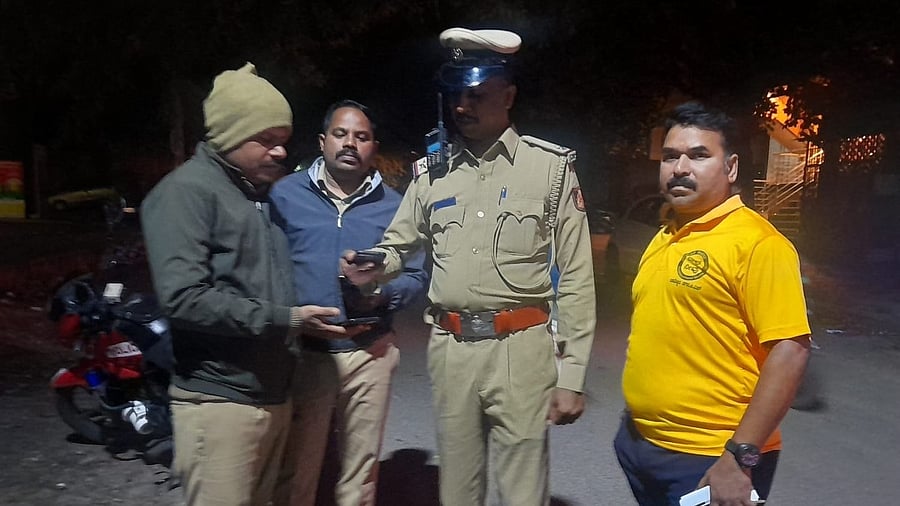
A volunteer under ‘Naavu Neevu’ with the police during the beat duty.
Credit: Bengaluru Police
Bengaluru: As the Covid-19 pandemic led to drastic societal changes, burglars broke their patterns. The police in Bengaluru have since focused on preventing burglaries, or house break-in theft (HBT) cases, and using tech to aid the investigation.
Data showed that HBT cases saw a 29.41% rise from 882 in 2022 to 1,142 in 2023 in the city.
Patterns break
Police divide burglaries into two categories: HBT Day and HBT Night. An inspector from the Whitefield division, where techies and other professionals reside, said that many burglars have begun breaking their patterns. “Earlier, a burglar who targeted houses in the day would operate only during the day, while a night burglar would operate only in the night,” the officer said. “Now, we are seeing that a burglar, who earlier operated in the day, is doing it in the night and vice versa.”
This change poses some challenges during the probe. Police maintain Modus Operandi Bureau (MOB) cards. These are tagged to offenders and describe their modus operandi. Further, they categorise the type of offence (day or night), how the offender broke in, their attire (if there is a pattern) and other such intricate details.
The changing patterns, another police inspector from the Whitefield division said, can confuse investigators as the MOB cards would state otherwise.
“Burglars earlier followed the same patterns: the way they broke open the houses, the entry points etc. They also stole the same things in most cases. For eg, some only steal gold or silver, as they know where to dispose them, without alerting the police,” the officer said.
Another police inspector said the use of medical masks and surgical gloves rose after the pandemic. “We have seen burglars using medical masks to cover their faces from CCTVs and use surgical gloves to conceal their fingerprints,” the officer said. “The occurrence is more post-COVID-19 as the masks and gloves are easily available. In some cases, due to negligence, the perpetrators get caught, while in others, investigators identify them based on their body language,” the officer said.
In a recent case in Marathahalli, a habitual burglar who wore a facial mask was caught when he exited the house after the crime as his face was seen in one of the CCTVs. His fingerprints were not found at the crime scene.
“Another pattern we observed in recent months is that earlier, robberies in areas where techies lived occurred during the weekends, as many would briefly leave the city. Now, we see burglaries on random weekdays. The culprits observe if a house is empty and break-in, shifting from their patterns,” the officer quoted above added.
While there have been cases of interstate burglar gangs operating in the city, police say their role is minuscule compared to the local culprits. “Investigators have kept a close watch on some of the gangs that were caught earlier,” a senior police officer said.
Prevention, awareness and tech
As culprits evolve, so do the police. Bengaluru City Police Commissioner B Dayananda said one of the key focuses of his investigators is prevention. “Earlier burglaries were on low priority compared to other major offences,” Dayananda said. “In the past year, we have realised that burglaries should be given due importance: From the point of detection and the point of prevention.”
For detection, tech has been a major boost. “One is the presence of CCTVs and the second is the Automated Fingerprint Identification System (AFIS), which has state and nationwide data. It helps the investigators identify the culprits through the chance prints or fingerprints from the crime scene,” Dayananda said.
“Maintaining MOB cards has been streamlined and fingerprint search slips would be generated, if not available in a police station, as it gets updated centrally,” he added.
For prevention, the city police launched the neighbourhood watch scheme, ‘Naavu Neevu’, in the West, North and South divisions, and will be rolled out to others. It was formally launched in the West division in July 2024.
“This aims at involving the local community in the night beat system and to create awareness as the biggest problem we see is locked houses easily identifiable through visible padlocks and piled up newspapers. Pamphlets on awareness are also given at toll plazas alerting the public if they fail to inform the police of their locked houses,” Dayananda said.
Voluntarily, people can join the police’s night-beat system. “They are provided jackets, caps and ID cards to motivate them and we use their expertise as they are well-versed with their neighbourhoods. The day-beat police staff has been directed to identify the locked houses and inform their stations so the night-beat can keep watch.”
Highlights - How to be safe? Don’t use visible padlocks Intimate the jurisdiction police station about travel plans Stop newspaper and milk subscriptions Refrain from keeping large quantities of valuables and cash Refrain from posting about travel plans on social media If possible, use theft alarms on doors and CCTVs Keep some lights on Do a background check while hiring house helps, maids etc